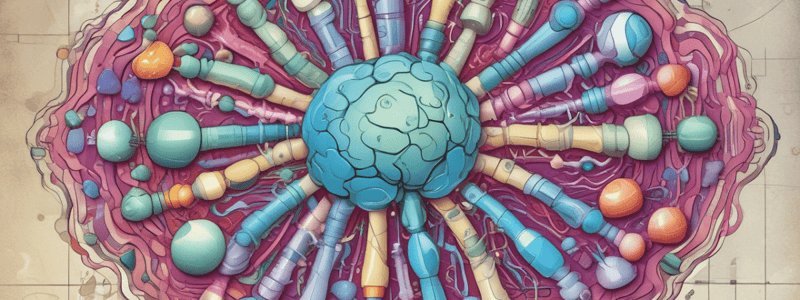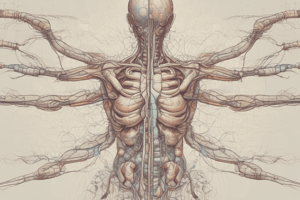Podcast
Questions and Answers
What is the primary mechanism of action of cholinesterase inhibitors?
What is the primary mechanism of action of cholinesterase inhibitors?
- Inhibiting the breakdown of ACh by acetylcholinesterase (correct)
- Directly stimulating nicotinic receptors
- Directly stimulating muscarinic receptors
- Increasing the release of ACh from nerve terminals
Which of the following is a serious side effect of cholinergic drugs?
Which of the following is a serious side effect of cholinergic drugs?
- Seizures (correct)
- Dizziness
- Diarrhea
- Headache
What is the clinical use of muscarinic receptor agonists in the treatment of glaucoma?
What is the clinical use of muscarinic receptor agonists in the treatment of glaucoma?
- Assisting in smoking cessation
- Relieving muscle weakness and fatigue
- Improving memory and cognition
- Reducing intraocular pressure (correct)
Why are cholinergic drugs contraindicated in pregnant and breastfeeding women?
Why are cholinergic drugs contraindicated in pregnant and breastfeeding women?
Which of the following is an example of a nicotinic receptor agonist?
Which of the following is an example of a nicotinic receptor agonist?
What is the primary use of cholinergic drugs in the treatment of Alzheimer's disease?
What is the primary use of cholinergic drugs in the treatment of Alzheimer's disease?
What is the common side effect of cholinergic drugs that affects the gastrointestinal system?
What is the common side effect of cholinergic drugs that affects the gastrointestinal system?
Which of the following is a contraindication for the use of cholinergic drugs?
Which of the following is a contraindication for the use of cholinergic drugs?
What is the mechanism of action of cholinergic drugs that increase the release of ACh from nerve terminals?
What is the mechanism of action of cholinergic drugs that increase the release of ACh from nerve terminals?
Which of the following is an example of a muscarinic receptor agonist?
Which of the following is an example of a muscarinic receptor agonist?
Which of the following cholinergic drugs increases the storage of acetylcholine in vesicles?
Which of the following cholinergic drugs increases the storage of acetylcholine in vesicles?
What is the primary effect of M2 and M4 muscarinic receptors on neurotransmission?
What is the primary effect of M2 and M4 muscarinic receptors on neurotransmission?
Which nicotinic receptor subtype is involved in neuronal excitability?
Which nicotinic receptor subtype is involved in neuronal excitability?
What is the primary effect of cholinesterase inhibitors on acetylcholine?
What is the primary effect of cholinesterase inhibitors on acetylcholine?
Which of the following is an effect of muscarinic receptor activation on the gut?
Which of the following is an effect of muscarinic receptor activation on the gut?
What is the primary mechanism of action of Lafutidine?
What is the primary mechanism of action of Lafutidine?
Which of the following is an effect of nicotinic receptor activation on cognitive function?
Which of the following is an effect of nicotinic receptor activation on cognitive function?
What is the primary use of donepezil in clinical practice?
What is the primary use of donepezil in clinical practice?
Which of the following is an example of a muscarinic receptor-mediated effect?
Which of the following is an example of a muscarinic receptor-mediated effect?
What is the primary mechanism of action of pyridostigmine?
What is the primary mechanism of action of pyridostigmine?
Flashcards are hidden until you start studying
Study Notes
Cholinergic Drugs
Definition
- Cholinergic drugs are a class of medications that mimic the action of the neurotransmitter acetylcholine (ACh) in the body.
- They work by increasing the levels of ACh in the brain or by stimulating the cholinergic receptors.
Mechanism of Action
- Cholinergic drugs can:
- Increase the release of ACh from nerve terminals
- Inhibit the breakdown of ACh by acetylcholinesterase (AChE)
- Directly stimulate cholinergic receptors (muscarinic and nicotinic)
Types of Cholinergic Drugs
- Cholinesterase inhibitors:
- Inhibit the breakdown of ACh by AChE
- Examples: donepezil, galantamine, rivastigmine
- Muscarinic receptor agonists:
- Directly stimulate muscarinic receptors
- Examples: bethanechol, pilocarpine
- Nicotinic receptor agonists:
- Directly stimulate nicotinic receptors
- Examples: nicotine, varenicline
Clinical Uses
- Alzheimer's disease: Cholinesterase inhibitors are used to treat symptoms such as memory loss and cognitive decline.
- Myasthenia gravis: Cholinergic drugs are used to treat muscle weakness and fatigue.
- Glaucoma: Muscarinic receptor agonists are used to reduce intraocular pressure.
- Smoking cessation: Nicotinic receptor agonists are used to help people quit smoking.
Side Effects
- Common side effects: nausea, vomiting, diarrhea, abdominal cramps, increased salivation
- Serious side effects: bradycardia, hypotension, seizures, respiratory failure
Contraindications
- Pregnancy and lactation: Cholinergic drugs are contraindicated in pregnant and breastfeeding women due to potential risks to the fetus or baby.
- Asthma and COPD: Cholinergic drugs can exacerbate respiratory conditions.
- Gastrointestinal disorders: Cholinergic drugs can worsen gastrointestinal conditions such as peptic ulcers and gastrointestinal obstruction.
Cholinergic Drugs
Definition
- Mimic the action of acetylcholine (ACh) in the body
- Work by increasing ACh levels in the brain or stimulating cholinergic receptors
Mechanism of Action
- Increase ACh release from nerve terminals
- Inhibit ACh breakdown by acetylcholinesterase (AChE)
- Directly stimulate cholinergic receptors (muscarinic and nicotinic)
Types of Cholinergic Drugs
Cholinesterase Inhibitors
- Inhibit ACh breakdown by AChE
- Examples: donepezil, galantamine, rivastigmine
Muscarinic Receptor Agonists
- Directly stimulate muscarinic receptors
- Examples: bethanechol, pilocarpine
Nicotinic Receptor Agonists
- Directly stimulate nicotinic receptors
- Examples: nicotine, varenicline
Clinical Uses
Alzheimer's Disease
- Cholinesterase inhibitors treat memory loss and cognitive decline
Myasthenia Gravis
- Cholinergic drugs treat muscle weakness and fatigue
Glaucoma
- Muscarinic receptor agonists reduce intraocular pressure
Smoking Cessation
- Nicotinic receptor agonists help people quit smoking
Side Effects
- Common: nausea, vomiting, diarrhea, abdominal cramps, increased salivation
- Serious: bradycardia, hypotension, seizures, respiratory failure
Contraindications
Pregnancy and Lactation
- Contraindicated in pregnant and breastfeeding women due to potential risks
Asthma and COPD
- Can exacerbate respiratory conditions
Gastrointestinal Disorders
- Can worsen gastrointestinal conditions like peptic ulcers and obstruction
Cholinergic Drugs
Acetylcholine Release
- Cholinergic drugs increase ACh release from neurons through mechanisms that increase ACh synthesis, storage, and release from vesicles.
- Examples of drugs that increase ACh release include Vesamicol, which increases ACh storage, and Lafutidine, which increases ACh release.
Muscarinic Receptors
- Muscarinic receptors are a type of cholinergic receptor with subtypes M1, M3, and M5, which stimulate neurotransmission, and M2 and M4, which inhibit neurotransmission.
- Activating muscarinic receptors increases salivation, sweating, gut motility, and secretion, while decreasing heart rate and increasing pupil constriction.
- Examples of muscarinic receptor agonists include Bethanechol, used to treat urinary retention, and Pilocarpine, used to treat glaucoma.
Nicotinic Receptors
- Nicotinic receptors are a type of cholinergic receptor with subtypes alpha-4 beta-2, involved in cognitive function, and alpha-7, involved in neuronal excitability.
- Activating nicotinic receptors increases cognitive function, memory, neuronal excitability, and dopamine release.
- Examples of nicotinic receptor agonists include Nicotine, used to treat nicotine addiction, and Varenicline, used to treat nicotine addiction.
Cholinesterase Inhibition
- Cholinesterase inhibitors block ACh breakdown by acetylcholinesterase, increasing the amount of ACh available for neurotransmission and prolonging its action.
- Cholinesterase inhibition increases muscle contraction, salivation, and sweating, and improves cognitive function.
- Examples of cholinesterase inhibitors include Donepezil, used to treat Alzheimer's disease, Galantamine, used to treat Alzheimer's disease, and Pyridostigmine, used to treat myasthenia gravis.
Studying That Suits You
Use AI to generate personalized quizzes and flashcards to suit your learning preferences.




